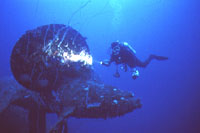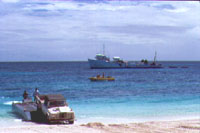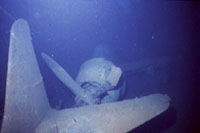![]()
"It's like walking on the moon -- only with more history" declared Washington attorney Jonathan M. Weisgall after he'd surfaced in Bikini lagoon from the flight deck of the sunken aircraft carrier U.S.S. Saratoga, the largest warship accessible to divers.
And, if Weisgall has anything to do with it, the Saratoga will be the centerpiece of the world's first underwater nuclear theme park, scheduled to open next summer at this tiny Micronesian atoll in the Marshall Islands.
"The collection of warships at Bikini will rival Truk Lagoon," Weisgall says. "What happened there is a turning point in world history."
 Ironically, Truk was on
America's short list of wartime A-bomb sites, along with Hiroshima and Nagasaki. Yet in
the history of atomic warfare Bikini looms large. It's fame -- and/or infamy -- may be
immortal, and for good reason. It was here in 1946, soon after Japan's surrender to Allied
forces, that the U.S. began a super-high visibility program of atomic testing, with
special attention focused on sending a warning to an aggressively imperialist post-war
Soviet Union.
Ironically, Truk was on
America's short list of wartime A-bomb sites, along with Hiroshima and Nagasaki. Yet in
the history of atomic warfare Bikini looms large. It's fame -- and/or infamy -- may be
immortal, and for good reason. It was here in 1946, soon after Japan's surrender to Allied
forces, that the U.S. began a super-high visibility program of atomic testing, with
special attention focused on sending a warning to an aggressively imperialist post-war
Soviet Union.
In all, more than 20 nuclear "devices" were detonated at Bikini, the largest of which, in 1954, was a 15-megaton hydrogen bomb. Code named "Bravo," it was the mother of all nuclear tests. Bravo sank one whole island, partially vaporized two others, and gouged a mile-wide crater in the floor of the lagoon.
But a generation has passed since 1946, when a joint Army-Navy project called "Operation Crossroads" initially unleashed two Nagasaki-type bombs on more than 95 target ships anchored in the lagoon.
The first test, on July 1, was an air blast code-named "Able." It crushed target ships like the steel-plated heel of an unimaginably huge boot. Three weeks later, an underwater blast created the world's first Chernobyl. Code named "Baker," it unleashed a mile-high radioactive dome of water, polluting everything in, under and around the 25-mile-wide lagoon -- including military personnel. Most of the ships were so contaminated they had to be towed and sunk at remote locations.
Baker was a public relations disaster. Eight years later, Bravo, a thousand times more powerful than the earlier weapons, served to seal Bikini's reputation as hell's own island.
 "In the beginning, we
told the Bikinians the tests were for the good of mankind," explains Weisgall, who's
been at the center of the political, scientific and human fall-out. The Bikinians
voluntarily departed their island, achieving the status of the world's first nuclear
nomads. American cash and assistance resettled them elsewhere in the Pacific. To this day,
the move has been beset by social and economic pain.
"In the beginning, we
told the Bikinians the tests were for the good of mankind," explains Weisgall, who's
been at the center of the political, scientific and human fall-out. The Bikinians
voluntarily departed their island, achieving the status of the world's first nuclear
nomads. American cash and assistance resettled them elsewhere in the Pacific. To this day,
the move has been beset by social and economic pain.
As the attorney representing the Bikinians and other Marshall Islanders effected by the atomic tests, Weisgall has won a massive class-action suit: $75 million for resettlement of the Bikinians, and more than $110 million for radiological cleanup of the atoll. In the meantime, Weisgall has authored a detailed and highly readable book on the subject, "Operation Crossroads: The Atomic Tests at Bikini Atoll" (Naval Institute Press), spelling out the history and perhaps even the future of the Bikinians. And the future, he says, definitely includes the underwater nuclear theme park.
 Bikini is a showplace of
"world significance -- time travel in the nuclear age," Weisgall says. The first
group of touring divers may arrive on the atoll as early as July, 1996. Except for tanks
and weights, divers will be expected to bring all their own equipment. No rentals will be
available, at least in the beginning. "This is strictly a start-up operation,"
Weisgall explains.
Bikini is a showplace of
"world significance -- time travel in the nuclear age," Weisgall says. The first
group of touring divers may arrive on the atoll as early as July, 1996. Except for tanks
and weights, divers will be expected to bring all their own equipment. No rentals will be
available, at least in the beginning. "This is strictly a start-up operation,"
Weisgall explains.
But is hell's own island safe after its violent radioactive past?
Yes, insists Weisgall, who has worked with Department of Energy (DOE) scientists and has visited the atoll more than 15 times: "You'll get more radiation exposure in Denver."
As a dive site, there are significant advantages. Like the 900-foot-long Saratoga, the target ships lie on a deep 150-175 foot bottom, but most of the superstructures are only 20 feet below the surface. The target ships are only 15 minutes by boat from the beach, and seas are typically calm in the sheltered lagoon.
Among the accessible vessels are the submarines Pilot Fish and Skate, the battleship Arkansas, and Admiral Yamamoto's flagship, Nagato, from which he directed the December 7, 1941, suprise "Tora-Tora-Tora" attack against Pearl Harbor.
Marine life has experienced a surprising rejuvenation. Its coral is vibrant and healthy, and the fish -- particularly grey reef sharks -- are abundant. And, with fishermen absent for 50 years, the lagoon is in rare, undisturbed condition. If there's a dark side, it's in Bikini's topside soil. You wouldn't want to eat the coconuts or anything else grown on the island. Radioactivity shows up in the plants.
 Another consideration: The
world's deadliest substance, plutonium, remains buried in the lagoon's sediments. Though
it's below the range of reasonable and safe SCUBA, mucking up the bottom might not be a
good idea.
Another consideration: The
world's deadliest substance, plutonium, remains buried in the lagoon's sediments. Though
it's below the range of reasonable and safe SCUBA, mucking up the bottom might not be a
good idea.
Still, the level of safety is such that the National Park Service's Submerged Cultural Resources Unit worked on-site to produce the proposal for the underwater park, patterning it after the successful Isle Royale, in Canada.
Dan Lenihan, chief of the Park Service unit, described the collection of capital ships as "an incomparable diving experience."
It was generally agreed that further development had to involve the Bikinians, and this, until now, has been the rub.
Understandably, the islanders were reluctant to return to what they perceived to be a "hot" atoll. In addition, their numbers had increased from 167 to more than 2,000 during their exile in the Pacific, compounding any resettlement plan.
"In 1946, we promised to take care of the Bikinians for life if they'd leave the atoll," Weisgall explains. It isn't easy, he says, to break the "victim mentality" and convince these nuclear nomads that they might participate in a commercial dive operation. A half-century later, the mindset has changed.
 Still, other practical
problems remain. For example, Bikini is located in mid-Pacific, 2,500 miles from Honolulu
and its airstrip can not accommodate large jets. There are island-hopping flights once a
week out of Majaro, the captial of the Marshall Islands, 300 miles to the south. Majaro is
served out of Honolulu by the Airlines of the Marshall Islands. The infrequency of flights
is one of the factors that keeps Bikini largely undeveloped and isolated.
Still, other practical
problems remain. For example, Bikini is located in mid-Pacific, 2,500 miles from Honolulu
and its airstrip can not accommodate large jets. There are island-hopping flights once a
week out of Majaro, the captial of the Marshall Islands, 300 miles to the south. Majaro is
served out of Honolulu by the Airlines of the Marshall Islands. The infrequency of flights
is one of the factors that keeps Bikini largely undeveloped and isolated.
At present there are no tourist accommodations. The DOE maintains a field station capable of housing up to 25 divers, "but it's hardly Club Med," Weisgall warns. "We'll have a French chef, and the place is comfortable enough. But, bottom line, the first divers will be roughing it."
The Bikinians believe the station is good enough, at least to get started in dive-tourism. Plans for other accommodations are being discussed, Weisgall says.
Pricing has yet to be fixed and no formal dive package is available. Weisgall says the Bikinians will announce details of pricing and future packaging early next year.
"Bikini is strictly for adventurous types," Weisgall admits. "But I think Americans will get into the romance of it. It's true adventure/travel. It's exotic, a world-class destination, and you can't beat the history."
Pictures were provide courtesy of the National Park
Service